Pushkin House exhibition ‘Russian Types & Scenes’
Wednesday, May 13th, 2015
Swan Lake, Vytegra, August 2014
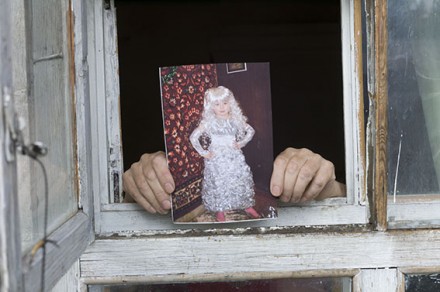
Snowflake, Kargopol, August 2013
19th June ‚Äď 20th September 2015, Private View 18th June, 7pm.

Swan Lake, Vytegra, August 2014

Snowflake, Kargopol, August 2013
19th June ‚Äď 20th September 2015, Private View 18th June, 7pm.
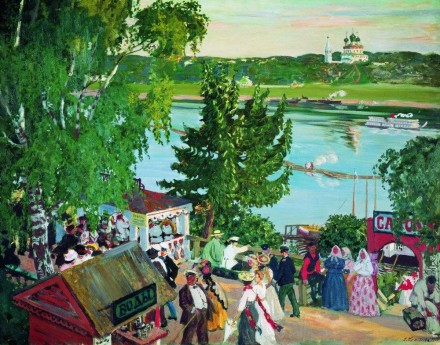
This painting ‘Promenade along the Volga (Romanov-Borisoglebsk)’ was painted by Boris Kostudiev (1878-19270) in 1909. In 1918, Romanov-Borisoglebsk was renamed in memory of the Red Guard I P Tutaev, who was killed in the Yaroslavl revolt of 1918. Tutaev is the home of the Shuvalov Bell Foundry. On the 30th of March this year the bell foundry cast six bells for the bell tower of the Church of the Transfiguration in Turchasovo.
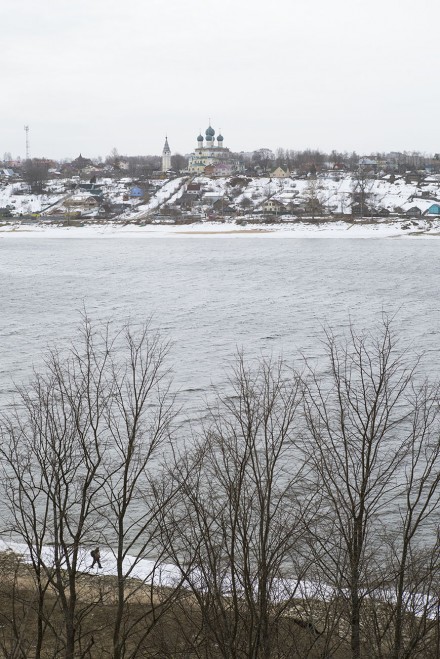
Tutaev March 2015
Alexander Mozhaev wrote the following about Tutaev and bell making for ‘Russian Types & Scenes’. . . The main street on the Romanov side of Tutaev, a town that straddles the Volga upriver from Yaroslavl, leads to the gates of the famous Shuvalov Bell Foundry. There had been no church bell foundries in Russia since the upheavals of the 1930s when the Soviets destroyed both the means and the know-how for producing bells. Nikolai Shuvalov was, until 1992, a gas pipeline engineer. He explains his decision to resurrect the art of bell making in Russia very simply: ‚ÄėIn the late eighties, when there was no life left in the pipeline business, I started freighting in fruit and vegetables from the south and managed to make enough money to put some aside. Although there was hardly an intact bell tower in the country I decided to put my money into bells, maybe because no one else was. After Ô¨Āve or so years of experimentation I started to produce decent bells, then the Ô¨āood gates opened and the orders started Ô¨āowing in.‚Äô
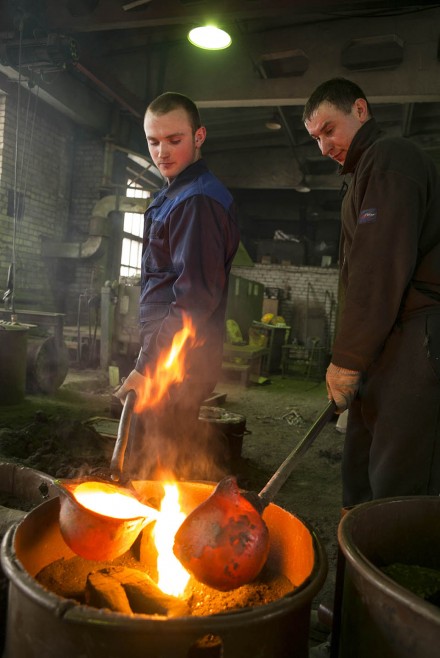
Pouring the metal
To a layman, the manufacture of a Russian bell looks impossibly complicated ‚Äď like writing with both hands while looking in the mirror. A bell is like sculpture cast in metal, it has to be fashioned, or rather, its opposite has to be fashioned with great skill and precision. Each bell is made from scratch and each bell has its own unique sound.
The knowledge that most of us have about the mysteries of Russian bell casting is nil, and any knowledge we do have comes from the bell making chapter in Tarkovsky‚Äôs extraordinary Ô¨Ālm Andrei Rublev. A young lad, who claims to have inherited the secret of bell making from his father, is commissioned to cast a colossal bell for the Grand Duke. The undertaking is on a gigantic scale. He tells the agents of the Prince ‚ÄėWe need more silver, tell the Prince not to be so stingy, we need another half pood‚Äô ‚Äď ‚ÄėIf we don‚Äôt you‚Äôll get a beam, not a bell.‚Äô ‚Äď ‚ÄėWho knows the secret of bell bronze? You or me?‚Äô As an aside, to his assistant he laughs and says ‚ÄėI‚Äôm going to shake a load of silver out of the Prince.‚Äô
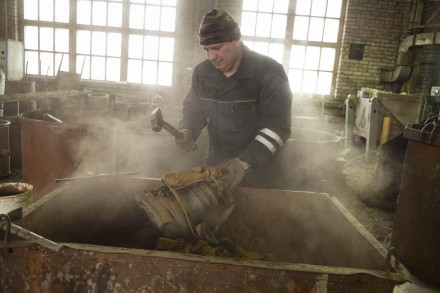
The cast is broken open
No expense is spared it seems! But it isn‚Äôt silver being thrown into the furnace, it is tin. Shuvalov explains, ‚ÄėBronze is an alloy of copper and tin, and at that time Russia imported much of its tin from England. But the English, as always, found a ruse to maximise their proÔ¨Āts and they would only sell tin in the form of tableware ‚Äď thereby adding a hefty premium. So Tarkovsky‚Äôs scene is pretty accurate, with its armfuls of white metal utensils being thrown into the furnace. The bell founders Ô¨āeeced their clients by demanding more and more silver. This was kept safe in the Ô¨Ārebox and later raked out with the ashes.‚Äô
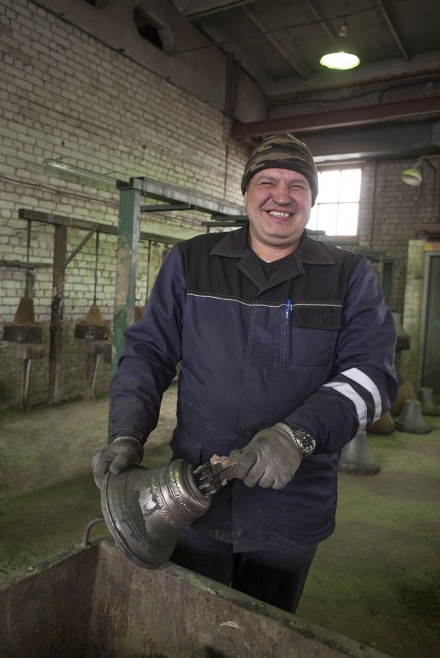
One of the newly cast bells
Maybe this story is nonsense but there is an old Russian saying ‚ÄėPouring bells!‚Äô (–ö–ĺ–Ľ–ĺ–ļ–ĺ–Ľ –Ľ—Ć—é—ā)¬† which means telling Ô¨Ābs and lies. As the old custom tells, creating a buzz in the crowd by spreading scandalous gossip during the casting, guarantees that the bell will sing!
Alexander Mozhaev, 2014
I’m pleased to record that much scandalous gossip was spread during the casting of the Turchasovo bells, in fact many words where used which Natasha Shalina, our interpreter from St Petersburg, refused to translate. A clue was given by her flushed cheeks and giggles!!
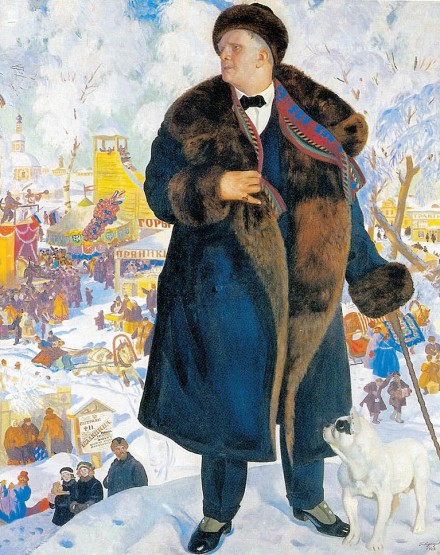
Feodor Chaliapin painted by Boris Kustodiev (1878-1927) 1922
Last weekend I went to Vienna to see a performance of the opera Khovanschina by Modest Mussorgsky. It’s an opera I’m always keen to track down. The music and the story are very powerful but apart from that I’m always intrigued to see how the final scene will be presented on stage. A scene where a community of Old Believers martyr themselves in a burning church rather than give themselves up to be slaughtered by the czars troops. Not an easy thing to stage.
I had great hopes for this production as it was directed by Lev Dodin. But despite a set made of charred timbers, no ‘coal effect fire’ lighting was attempted and no wind machine blown red silk used. And the protaganists and chorus were slowly lowered below stage, not raised to heaven. Apart from that the singing was great and the Vienna State Opera Orchestra conducted by Semyon Bychkov sounded wonderful.
Another plus was an English language programme where I came across this quote from Chaliapin ‘As a composer, Mussorgsky sees and hears all the scents of a garden or a tavern, and describes them so strikingly and persuasively that the audience finally hears and shares those aromas‚Ķ That is realism, to be sure, but a realism of a special kind, such as we are familiar with from Russian peasants who with plain timber and simple axes build a church whose artistic ornamentation surpasses even the best inlaid work.’
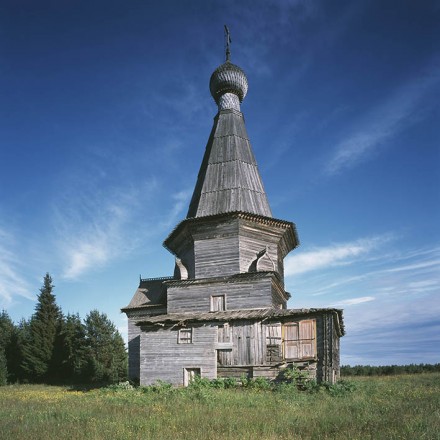
The Church of St Nicholas, Purenema, Archangel Region, July 2012
Liadiny was blest with a magnificent collection of wooden church architectecture.
St Blaise’ Church of the Intercession built in 1761, the Church of the Epiphany built in 1793 and a fine 18th century bell tower. It was one of the few remaining three-part ensembles in Russia ‚Äď summer church, winter church and bell tower. The Church of the Intercession had, unusually, retained its iconastasis resplendent with many icons together with a beautiful heavenly blue sky-ceiling.The churches had survived their desecration during Soviet times when they had been used as barns but sadly the Church of the Intercession and its bell tower are no more. The Church was struck by lightening on the 5th May this year ‚Äď Easter Sunday.
links below to Matilda Moreton’s account of the tradgic events in English and Russian
http://www.opendemocracy.net/od-russia/matilda-moreton/easter-fire-descends-on-lyadiny
http://www.archnadzor.ru/2013/06/01/nebesnyiy-ogon-v-lyadinah/
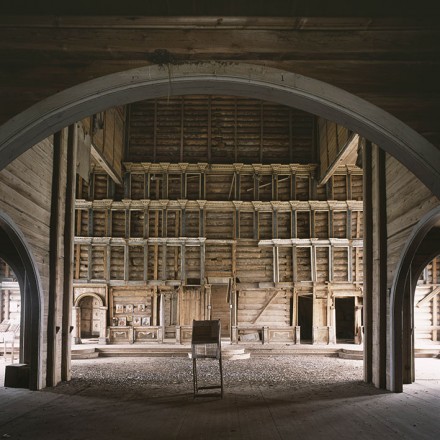
Church of the Transfiguration (1781), Turchasovo, Onega district, Archangel region
This heartrending book provides a glimpse into the culture of Russian religious faith and its expression in the fragile wooden churches that hover in the northern landscape imparting presence and deep meaning. Heartrending because these churches and the religious civilisation they represent are now abandoned and disappearing through neglect. They will soon be extinct. Silhouetted against grey skies in the vast northern emptiness their onion domes, tent-shaped steeples and eccentric bell towers silently recall the relationship between earth and sky, between man and Eternity. Delicate, harmonious and utterly unpretentious, their beauty is unimaginable by the standards of our corrupting materialism. They are the last echo of the great spiritual resurgence in the late 14th century emanating from Saint Sergius of Radonezh whose followers founded four hundred monasteries, many of them in the Russian North.
To enter such a wooden church is like boarding a great galleon that has landed from the sky and in which, with all one’s senses attuned to new possibilities, one feels ready to ascend into Infinity.
Dick Temple